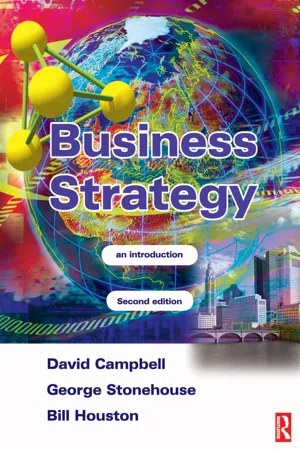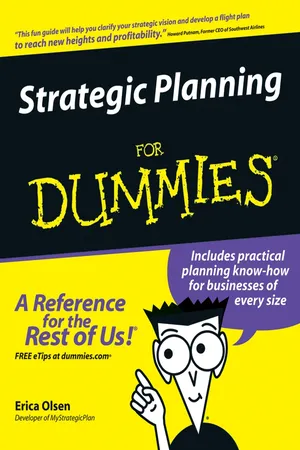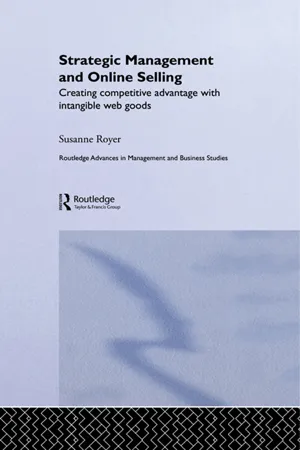Competitive Advantage
Competitive advantage refers to the unique attributes or strategies that allow a company to outperform its competitors. It can be achieved through cost leadership, differentiation, or focus. By possessing a competitive advantage, a company can attract more customers, generate higher profits, and maintain a strong market position.
8 Key excerpts on "Competitive Advantage"
- eBook - ePub
- George Stonehouse, Bill Houston(Authors)
- 2003(Publication Date)
- Routledge(Publisher)
...Competitive Advantage can arise both from planned strategies and from opportunistic moves by the business – sometimes called emergent strategies. Competitive Advantage is not easy to achieve and is even more difficult to sustain. Superior performance is built and sustained through continuous organizational learning and results in a constant process of new strategy development and improvement in the way in which business activities are carried out. The rapid pace of technological, political, economic and social change, the increasing turbulence of the business environment, the growing sophistication of customer needs and the drastic shortening of product life cycles that typifies ‘hypercompetition’, all mean that Competitive Advantage is often contestable rather than sustainable. In other words, the search for strategies that produce and sustain superior performance over a long period of time has become increasingly difficult. Competitive Advantage can only be developed and sustained through the creation of new business knowledge based upon continuous organizational learning. In Chapter 1 of this book, we learned that the different strands of theory in strategic management offer several explanations and potential methods by which Competitive Advantage can be achieved. The ‘competitive positioning’ explanation is based largely upon Porter's five forces, generic strategy and value chain frameworks (Porter, 1980, 1985) which have been subsequently augmented by the concept of a hybrid strategy. For Porter, the first question to be answered was: In which industry should the business compete? Potential industry profitability, and hence attractiveness, was established through five forces analysis. Once the choice of industry was made, the organization then had to determine which generic strategy to pursue, and then to decide the optimum configuration of its value-adding activities to support the chosen generic strategy...
- eBook - ePub
- Robert M. Grant, Judith J. Jordan(Authors)
- 2015(Publication Date)
- Wiley(Publisher)
...For example, by allowing customers to state their food preferences in advance the airline offers a personalized service while at the same time eliminating waste. By speeding up the check-in process, the airline enhances the travel experience of its passengers but also improves punctuality and reduces the costs incurred by delays. Summary Making money in business requires establishing and sustaining Competitive Advantage. Both these conditions for profitability demand profound insight into the nature and process of competition within a market. Competitive Advantage depends critically on the presence of some faults in the competitive process – under perfect competition, profits are transitory. Our analysis of the imperfections of the competitive process has drawn us back to the resources and capabilities that are required to compete in different markets and to pursue different strategies. Sustaining Competitive Advantage depends on the existence of isolating mechanisms: barriers to rivals’ imitation of successful strategies. The greater the difficulty that rivals face in accessing the resources and capabilities needed to imitate or substitute the Competitive Advantage of the incumbent firm, the greater the sustainability of that firm’s Competitive Advantage. Hence, one outcome of our analysis is to reinforce the argument made in Chapter 3 : the characteristics of a firm’s resources and capability are fundamental to its strategy and its performance in decision making and long-term success. Summary table Learning Objectives Summary Understand the meaning of the term ‘Competitive Advantage’ and identify the circumstances in which a firm can create a Competitive Advantage over a rival When two or more firms compete within the same market, one firm possesses a Competitive Advantage over its rivals when it earns (or has the potential to earn) a persistently higher rate of profit...
- eBook - ePub
Business
The Ultimate Resource
- Bloomsbury Publishing(Author)
- 2011(Publication Date)
...Sustaining Competitive Advantage GETTING STARTED You know your products and your customers, but how do you know what type of marketing and communications will be effective? What makes your business unique? What makes you better than your competitors? To market yourself successfully, it’s essential that you understand your Competitive Advantage—what differentiates you and makes you a more suitable supplier. The differentiators could be product performance, price, quality, capacity, delivery time, or financial stability. The starting point is to identify your Competitive Advantage and build the elements of that advantage into customer communications and marketing programs. FAQs Is “Competitive Advantage” as simple as having an advantage over your competitors? What does it really mean? According to author Michael Porter, when a firm sustains profits that exceed the average for its industry, the firm is said to possess a Competitive Advantage over its rivals. A primary goal of business strategy is to achieve a sustainable Competitive Advantage. How can my organization maintain its Competitive Advantage? Commentators now believe that sustainable Competitive Advantage is linked to an ability to innovate. Although investment in improvements to existing products and processes does bring growth, innovative breakthroughs are what enable a company to take advantage of changing market conditions, thus supporting continued growth and creating a high return on investment. MAKING IT HAPPEN Understand and Analyze Your Competitors Before you can identify your own Competitive Advantage, you must understand your competitors. Competitive intelligence like this can be useful for marketing, pricing, managing, and other aspects of strategic planning...
- eBook - ePub
- Erica Olsen(Author)
- 2011(Publication Date)
- For Dummies(Publisher)
...If one of the most successful businessmen of today puts this at the top of his list, you should too. So what is it exactly? Your Competitive Advantage is what you, your company, or your department does better than anyone else. It is what makes you unique. The sustainable part refers to your ability to continue to do those activities over a long period of time. And yes, you can have more than one advantage and you can develop advantages as well. You don’t have to possess them all at this moment. I can’t emphasize the importance of understanding your Competitive Advantage enough. When you really have it nailed down, it helps you and your staff recognize the following: Which opportunities to pursue and which to pass by Where to allocate resources and where to cut back How to do what you already do well, better Know the difference between an opportunity and a distraction When to outsource (to another department or externally) and when to keep it in house Your Competitive Advantage(s) is the foundation, the cornerstone of your strategic plan. Throughout your planning process, you evaluate every part of your plan to determine whether it supports or detracts from your Competitive Advantage. In the process, you discover what draws customers to buy the product or service from you instead of the competition. Knowing how to define your Competitive Advantage is the first step toward applying it to your organization. Ninety-five percent of all companies don’t know their Competitive Advantages, let alone how to use them to communicate a compelling reason to choose their product or service. If Buffet examined your company, would he find what he’s looking for? You find out in the sections to come. The 30-second competitive advantage challenge Here’s a 30-second test to determine if you know your Competitive Advantage. A test already? I know; you feel like you’re in school again, don’t you? Don’t worry — it won’t hurt...
- eBook - ePub
Strategic Marketing
An Introduction
- Tony Proctor(Author)
- 2014(Publication Date)
- Routledge(Publisher)
...Chapter 9 Sustainable Competitive Advantage and generic strategies INTRODUCTION Keeping the strategic window open involves maintaining a sustainable Competitive Advantage. In consequence, we argue that Competitive Advantage should be market led. We examine the nature of core competencies and interpret their importance as the basis of gaining a sustainable Competitive Advantage in the market place. Along with these core competencies are a number of generic strategies that an organization can seek to follow or implement. We will look at each of these generic strategies in turn. First we will look at low-cost, focus and pre-emptive strategies and differentiation strategies. The latter leads us to consider product and service quality, customer focus and relevant issues relating to brand management. Competitive Advantage SHOULD BE MARKET LED It can be argued that an organization's products and services constitute the main focus of competitive strategy. In this context the aim is to offer a competitive bundle of benefits, or value, to the customer. Competitive Advantage is achieved through the positioning of one firm's offering relative to another. An alternative view suggests that it is superior resources and processes designed to utilize such resources efficiently that will create a Competitive Advantage. Both approaches are not mutually exclusive and can be complementary (viz. Hunt and Morgan, 1995; Verdin and Williamson, 1993). Indeed, such a view is in keeping with the view of keeping open the strategic window of opportunity. CORE COMPETENCIES AND Competitive Advantage It seems reasonable that Competitive Advantage should be developed on the basis of core competencies. Through the identification of its distinctive competencies and the relating of them to its core products, a firm can develop strategies and plans which make best use of those capabilities. New capabilities might then be sought after in order to achieve greater sustainable advantage...
- eBook - ePub
- Kenneth M. Eades, Timothy M. Laseter, Ian Skurnik, Peter L. Rodriguez, Lynn A. Isabella, Paul J. Simko(Authors)
- 2010(Publication Date)
- Wiley(Publisher)
...9 Strategy—Defining and Developing Competitive Advantage The purpose of business is to create value for people, including customers, shareholders, employees, and communities. Strategy defines the purpose, intent, and mission of the firm—how it aims to create value. Sustained superior returns require a clear and well-communicated vision of how the firm creates value. Leaders have a critical role in defining and clearly communicating these goals and in demonstrating commitment, courage, and resolve. Jim Collins’s study of firms with extraordinary performance over a sustained period of time found that leadership is critical, but perhaps not in the ways that are usually assumed. Superb leadership is characterized not by power and charisma, but by humility and firm resolve. Consistent with this finding, strategy development requires the firm’s leaders, at all levels, to understand the firm’s core values and to continually look hard at how to be ever more unique and valuable and how to stay true to not only to the firm’s mission, but to what the firm does not do. This chapter looks at the strategy development process, which provides frameworks and questions that leaders throughout the firm can use to design and improve strategy and performance. Strategy overlaps well with marketing; see also Chapter 4 on marketing management. What Is Strategy? Firms strive for sustained, superior return on investment. Superior returns, relative to other competitors in the industry, require a sustainable Competitive Advantage (that is, a way of providing value to customers that is unmatched by competitors). Sustained profits require investment in capabilities that enable the advantage to improve, renew, and change. Strategy, therefore, is concerned with the definition of Competitive Advantage and the development of activities, resources, and capabilities that enable the firm to sustain advantage in a changing world...
- eBook - ePub
Commercial Due Diligence
The Key to Understanding Value in an Acquisition
- Peter Howson(Author)
- 2016(Publication Date)
- Routledge(Publisher)
...Successful differentiation must create enough value for customers to allow the firm to recoup the extra cost either in the form of premium prices or increased market share. As a company strategy, differentiation tends to be a more secure basis for Competitive Advantage than is low cost. This is because cost advantage is vulnerable to unpredictable external forces, new technology and strategic innovation. As a result, companies that have been consistently successful over long periods tend to be those that have pursued differentiation rather than cost leadership. 16 Differentiation is closely linked with what was discussed in Chapters 3 and 5. It is about understanding the target’s customers and the needs its product is satisfying: Who are the customers? How does the product or service create value for them? Does it do it more efficiently and effectively than anyone else? The potential for differentiating a product or service is partly determined by its physical characteristics, but differentiation extends beyond physical characteristics to encompass everything about the product or service that influences the value customers derive from it. This means that differentiation includes every aspect of the way in which a company does business. Understanding differentiation begins with understanding why customers buy a product or service. What are the needs being satisfied? In getting this understanding, simple, direct discussions about the purpose of a product and its performance attributes are far more useful than market research data obtained from large samples of actual and potential customers. Figure 6.8 summarizes some key points of these discussions. Figure 6.8 Identifying differentiation The process outlined in Figure 6.8 will match differentiation to segmentation. It will also show the degree of differentiation of the different market players...
- eBook - ePub
Strategic Management and Online Selling
Creating Competitive Advantage with Intangible Web Goods
- Susanne Royer(Author)
- 2013(Publication Date)
- Routledge(Publisher)
...However, at least implicitly, even early concepts of the resource-based view acknowledge the necessity of customer benefit. Recent contributions even fully internalize the orientation toward sales markets. 108 In summary, the resource-based view of the firm in spite of the outlined criticism contributes in various ways to the explanation of long-term Competitive Advantage realization. In Peteraf’s (1993) terminology there are four cornerstones of Competitive Advantage from a resource-based perspective: (1) resource heterogeneity that leads to rent creation for single firms; (2) ex ante limits to competition that prevent costs from offsetting the rents; (3) ex post limits to competition that are necessary to sustain the resulting rents; and (4) imperfect mobility that ensures that the created rents stay in the firm and are appropriated by it. None of the necessary conditions alone is enough to obtain sustainable (i.e. long-term) Competitive Advantage, but together the few necessary conditions are sufficient to produce sustainable Competitive Advantage. Figure 3.1 summarizes the conditions for Competitive Advantage realization as specified by Peteraf (1993). Figure 3.1 Requirements for sustainable Competitive Advantage. (Source: Adapted from Peteraf, 1993: 186.) Resources that lead to sustainable Competitive Advantage from a resource-based perspective have to fulfill four conditions: 109 1 Such resources have to be valuable, i.e. have to improve firm effectiveness and efficiency 2 They have to be scarce, i.e. different from the resources of other firms 3 They have to be non-substitutable, i.e. other firms should not possess other resources that fulfill the same purpose 4 They should be inimitable, i.e. competitors should not be able to copy them...







